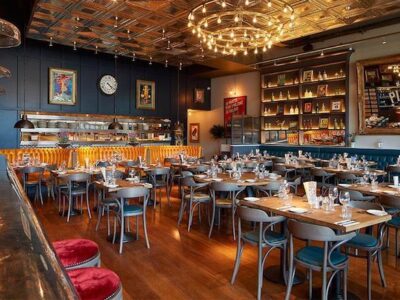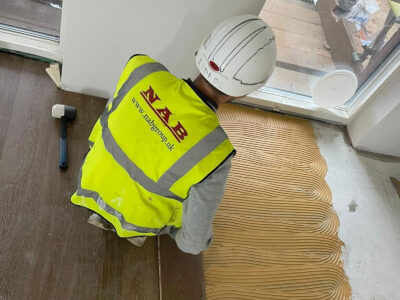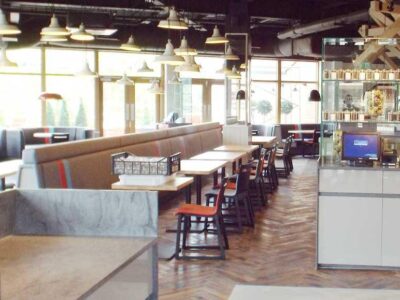Engineered wood flooring is now accepted as the preferred option for wood floors. There are numerous reasons for this but the main ones are listed below:
Stability: An engineered wood floor will not twist, warp and cup like solid wood or leave gaps in winter when the central heating is on and then expand (even pushing walls out) during a humid summer.
Quick and Easy installation: there is normally no need to acclimatise engineered flooring unlike solid wood unless you have underfloor heating
Sustainability: we can manufacture between three to four times more wood flooring from the same tree and use faster growing trees for the plywood like birch and eucalyptus. On our wider wood floors we use the cut waste to finger joint a middle layer and a back layer to create a stable very wide (340mm) engineered oak floor using 100% oak
How many times have you heard the saying “Never buy Cheap” as you just end up buying problems, at the end of the day you always get what you pay for.
We have tried to explain below the difference between the quality engineered flooring we manufacture compared to the “cheap” options of wood flooring available in the retail market.
What is the difference between cheap imported wood floors and the more expensive engineered wood floors manufactured by professional companies such as The Solid Wood Flooring Company.
There is a plethora of cheap wood flooring which has been produced using inferior adhesives containing excessive formaldehyde and made without reference to European or British standards. This might not seem important and may not affect your floor in the short term but after even a few months you may have issues with the finish and the top layer.
There are two methods for producing the top layer and they are compared below
Cut Veneer: The hardwood wear layer is produced just like a solid oak board. The tree is normally air dried, and then cut into thick planks. These are kiln dried and then sawn into a 6mm or 8mm veneer which is what we call the wear layer on an engineered board. This layer is carefully machined to create a high quality veneer that is both smooth and consistent in its dimensions. This process produces a board that has the same feel and grain appearance of a solid board. By cutting into thick logs and kiln drying them and then cutting the veneer it means that the wear layer is calibrated to a consistent thickness which avoids thick spots in the board and in turn would mean that the board is not evenly pressed and could end up inconsistently bonded.
The veneer is then coated by machine to get a consistent covering with a pre-mixed Dynea Adhesive before laying on top of a quality approved pre cut piece of multilayer plywood. The plywood we use has a consistent thickness in each layer and is kiln dried to the same moisture level as the veneer.
These boards are then loaded into a cold hydraulic press at more than 5000 tons pressure per square metre to ensure that the adhesive penetrates the cell structure of the plywood board and solid oak veneer (the same method is used for our exotic, walnut and maple engineered flooring) and left to cure. Once this is completed the boards are “balanced in a kiln to ensure that the level of moisture in both the solid top layer and the plywood is the same before being processed in a profiling machine and finishing line and then packed in our cartons for total protection.
Sliced Veneer:This is where the log is soaked in hot water sometimes with a chemical added to soften the timber ready to be placed on a machine where it is sliced. The best way to describe this is to compare the tree to a roll of carpet. The large veneer slicing machine “peels” the veneer as the log is turned. This produces a lot less waste as it just peels each layer continuously from 3mm to 6mm thickness. This makes the oak a darker colour and also there is little heartwood in such veneers as they cannot slice near the centre of the tree. The veneer is also liable to splitting in later life especially when used over underfloor heating because they have altered the cell structure during slicing by expanding it with water which they need to do to be able to slice the log in the first place.
The comparison chart below shows the major differences and when you want a particular colour or finish you will only achieve it if we supply the wood and oils, we cannot be held responsible if you choose a different wood that has been made differently to try and achieve the same finish as we do on our wood it is not possible.
Top Quality Engineered Flooring made by The Solid Wood Flooring Company
vs
Cheaper imported wood flooring made by various companies overseas
CONSTRUCTION
SWF –
6MM OR 4MM SOLID OAK TOP LAYER OF EUROPEAN OR RUSSIAN OAK ON 14MM OR BIRCH PLY
Alternatives – 1.5mm, 2mm 3mm or 4mm Chinese Oak on poplar core with poplar back layer or on 6mm Chinese Oak wear layer on mixed species plywood back layer
BONDING
SWF – Dynea pre mixed adhesive glued and cold pressed for the best bonding results. Every board is tested to check that it is properly bonded A sample of boards are laboratory tested each week to monitor how the bonding works in extreme conditions. Testing is undertaken and certified by independent professional companies
Alternatives – Quickly hot pressed with a wide variety of chemical adhesives, containing formaldehyde and other harmful toxins. The risk of delaminating is far higher with this type of pressing. Glues are heavily diluted and under applied to save money
HARDWOODLAYER
SWF – The hardwood wear layer is produced as per a solid oak board. This means that it is airdried, kiln dried and then sawn into a 6mm wear layer. The process produces a board that has the same grain appearance of a solid board. It is also very important that the wear layer is calibrated to a consistent thickness as this avoids thick spots in the board and in turn means that the board is evenly pressed and also consistently bonded.
Alternative – The hardwood layer is produced totally differently. Oak logs are soaked in hot water (sometimes with chemicals) to soften the timber. Once soft the logs are rotary sliced with a veneer knife into layers anything from 1.5mm to 6mm thick. This process turns the Oak a darker, grey colour. The hardwood layer is produced totally differently. Oak logs are soaked in hot water (sometimes with chemicals) to soften the timber. Once soft the logs are rotary sliced with a veneer knife into layers anything from 1.5mm to 6mm thick. This process turns the Oak a darker, grey colour.
BACK/CORE LAYER
SWF – Birch or Eucalyptus Ply. 10 layers bonded together –
Each layer is made with a complete piece of veneer. Controlled veneer thickness all birch, not mixed species.
Extra resistance and increased stability due to 10 layer construction of high quality plywood.
We also use Eucalyptus for our plywood as it is faster growing than Birch and harder and we have 10 layers of cross ply. These trees come from managed forest so are certified to be sustainable. We source all our timber from sustainable forests
Alternative – Poplar block board version:
Poplar is a soft low tensile timber
The block board construction is comprised of a thick section of the fast growing poplar tree that makes up the structural part of the board, bonded to a 1.5 or 2mm poplar veneer on the back of the veneer. This is the standard construction for a non-structural floating floor, but with a thicker core layer.
Even though the board looks thicker it is not as strong as it looks. The core layer is just strips laid next to each other and unlike plywood construction offers no structural support. Far Eastern Plywood versions will contain different wood species which are bonded together to make a low cost plywood.
Even though the board looks thicker it is not as strong as it looks. The core layer is just strips laid next to each other and unlike plywood construction offers no structural support. Far Eastern Plywood versions will contain different wood species which are bonded together to make a low cost plywood.
The veneers are inaccurately cut so the thickness of the final sheet varies. All the veneers should be the same thickness to produce a stable plywood If you can see on the back of the board that the plywood has been heavily sanded, then it is unlikely to have been properly produced wood sourced from dubious locations with no documentation.
LENGTH
SWF – 2200mm packs with one nested layer for widths over 189mm and for 150mm wide lengths of 1860mm
Alternative – Usually random lengths with an average of 650mm or 1800mm long with nested layers
THICKNESS
SWF – 20mm
Alternative – 10mm, 12mm, 14mm,18mm sometimes 20mm
WIDTH
SWF – 150, 180, 189mm 220mm, 260mm and (340mm with Oak core)
Alternative – 148mm/189mm sometimes 220mm
MACHINING
SWF – High tech moulded and quality checked using Homag profiling machines
Alternative – Poor quality profiling with lipping between different boards on the surface. Difficult to fit tongues and grooves
BOWING
SWF – Well balanced moisture content of the wear layer and core layer. Each board is left to rest for a day after bonding to settle and then put on battens for circulation in a kiln to balance the moisture content of the solid top layer and plywood base
Alternative – Excessive variations in the moisture content of the wear layer and core layer, even plywood will cause the boards to heavily bow, twist, cup and crown. There can also be problems in 6 months to 1 years time
WIDTH VARIATION
SWF – Precisely machined to +/- 0.25mm
Alternative – Sold as +/- 1mm – i.e. can have 2mm gaps between boards and still be within manufacturers parameters
WEAR LAYER
SWF – 6mm after sanding
Alternative – Varies 1.3 to 3.5mm to 6mm
DRYING
SWF – Slowly Kiln dried 8-10% to British Standard BS8201 – Air dried for 6 months
Alternative – Fast dried in veneer chamber in 45mins.
FINISHING
SWF –
Two coats of Timberex Heavy Duty UV Oil, or WOCA Master Oil or 9 coats Bona Industrial Naturale lacquer using base coats for added protection. These are applied on a professional finishing line with 10 stations (see our manufacturing facilities on the web site) where the lacquers and oils are cured using infra light to give the hardest finish available in the UK market
Alternative – One coat of a petro chemically derived oil. Difficult to clean, attracts dirt that becomes ingrained. or cheap lacquers with aluminium oxide that can leave white mark when scratched. Heavy lacquer with poor scratch and impact resistance. Lacquer splits rather than folds into dents. Once the oak is not fully protected from dirt/water it turns black
OTHER TREATMENTS
SWF – Antique hand distressed (actually done by hand and not machine), fumed, double fumed, neutral lacquered, brushed, double brushed and oiled, French grey, weathered, and many more coloured finishes where we finish to your exact requirements.
Alternative – Narrow range of options normally offered such as stains and lacquer with yellowing oak and machined distressing which has straight ripples and is normally too deep so it does not look natural.
CERTIFICATION
SWF – Professional and legal approach to documenting where timber comes from with far-reaching on sequences for organisations that flout the rules you can find us on the FSC web site as having a full chain of custody for all our sources of timber.
Alternative – Widespread abuse of the certification system with over 300 FSC licenses revoked due to improper usage. Check if the seller is claiming that it is from a sustainable source, and then check to see if they are registered with the FSC
SERVICE AND AVAILABILITY
SWF – Our products are continually available, even with special finishing or grading requirements. If you buy a floor and need some more this will never be a problem
Alternative – Product specifications continually change and if no stock is available the wait can be long – even if you only need one pack!
Related News Stories
Join our mailing list
Receive the latest news, offers and inspiration straight to your inbox.




